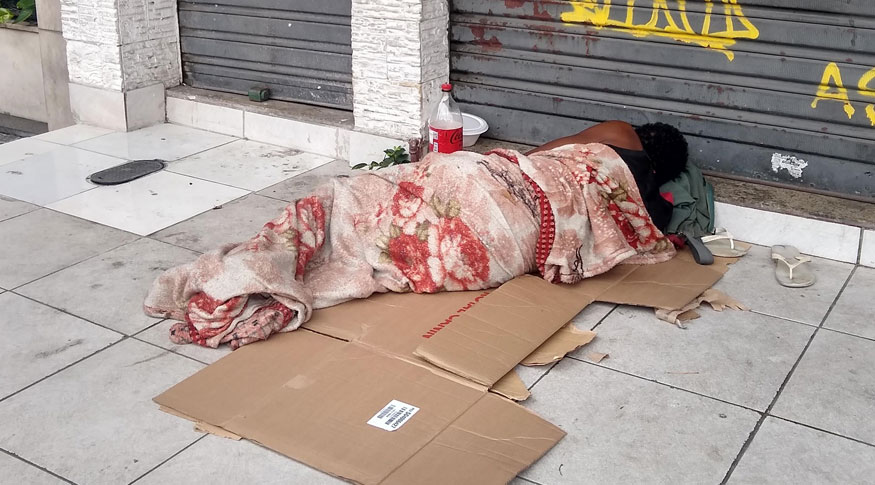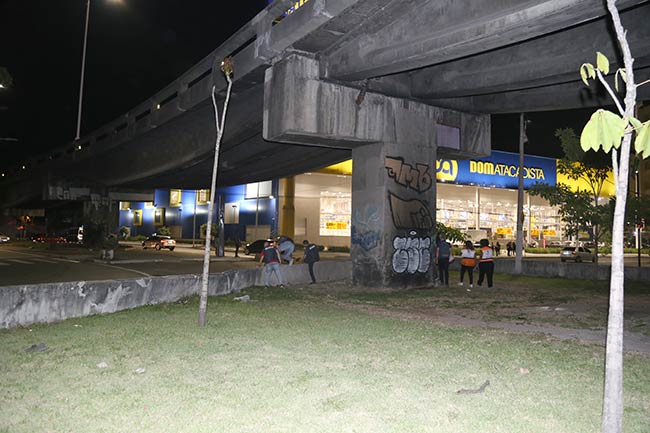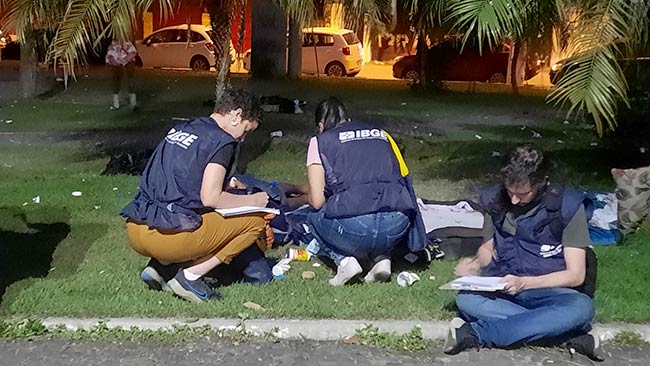IBGE conducts preliminary study for survey on the homeless population
December 11, 2023 05h46 PM | Last Updated: December 13, 2023 02h15 AM

The IBGE concluded, last Friday (8), one step of a preliminary study about the homeless population. The tests, conducted in Niterói (RJ), are part of a lab study that will enable the Institute to develop the first national survey on the homeless population living in the street of Brazil.
The teams were trained last week and this step was conducted between Monday (4) and Friday (8). On the first day, there was a process of sensitization of that population, who received informative material and talked to members of the IBGE team as an incentive to answer and return the questionnaires. On the 05, 06 e 07, IBGE agents went into the field to start the data collection tests, always at 6pm.
The project manager of the IBGE Directorate of Surveys, Luciano Duarte, sees the tests steps as positive: “There were no serious occurrences. We faced some expected situations, like refusals, areas where contact was impossible, team members without any experience to deal with the homeless, nothing unexpected. The test was important for us to assess our logistics, the routes, and it was an opportunity for observation.”
Mr. Duarte highlights, however, that the experience in Niterói is part of an initial step. “It is important to say it is not a census operation, or a census rehearsal. It is only an initial study to balance, in technical terms, the approaches, training, coverages and to implement data collection methodologies. Then, when it is possible, we will conduct the survey.”
The study had the objective of assessing six axes: aspects of the initial approach with municipal authorities and actors from local civil society, such as movements and NGOs, religious entities; to understand aspects related to spatial delimitation for the operation, as well as data collection routes; to assess aspects related to field logistics; to accumulate inputs that can be employed in later phases regarding methodological and conceptual definitions. “It’s a challenge because the methodology is different from those adopted by surveys in the IBGE,” Mr. Duarte explains.

Choice of Niterói follows technical criteria; a total of 48 persons covered four city zones
The city of Niterói, in the Metropolitan Area of Rio de Janeiro, was chosen because of some methodological criteria: it has a population of up to one million residents; 500 plus homeless persons listed under the Federal Government’s Unified Registry for Social Programs; it has at least two shelters for adults and families and at least one Special Center for the Homeless Population. Also, a determining fact was being a place demanding few logistical resources to guarantee the effectiveness of execution of the dimensions tested and observed, as well as a better potential of interaction with local actors,” Luciano Duarte adds.
A total of 50 persons, separated into four teams, worked in the test. The city was divided into four zones (Downtown 1, Downtown 2, North Zone and South Zone) and each zone had four routes. Thus, a total of 16 routes were mapped by a data collection team which had a focal member, a representative of the city administration in the field of Health or Social Assistance, a group coordinator, besides four interviewers who will work in pairs, five observers and a driver

The study also had external observers from ministries and partner institutions, such as the Institute for Applied Economic Research (Ipea), the Ministry of Developmement and Social Assistance, Family and Combat to Hunger, the Ministry of Human Rights and Citizenship, the UN Population Fund, the Pereira Passos Municipal Institute for Urban Planning (IPP) and the Inter-Sectorial Committee for Monitoring the Policy for Inclusion of Homeless People (Ciamp-Rua).
Test approached population in the streets and in different types of shelters
The population surveyed is described in Decree 7.053/2009, which establishes the National Policy for the Homeless Population, divided into three categories. “In the Streets” approached individuals found in the streets, Where They had slept at least one night in the seven days prior to data collection, and those who were under canopies and on sidewalks, for example, besides the ones in specific areas where people gather for using drugs, having slept in the street at least one night in the seven days preceding data collection.
The category “In buildings”, refers to individuals who are in areas permanently non-residential locations that are decayed or unfinished, and persons in residential locations, but whose structure is decayed or unfinished, and who slept in the buildings, in the streets, or in a shelter at least one night in the seven days preceding the survey. Persons in institutions such as shelter units, therapy communities, hospitals and Centers for Psychosocial Care (CAPS). In this case, the managers of each institution answered an individual questionnaire. There was also data collection in areas for temporary detention, and a questionnaire answered by the local manager.
Difficulties in routes, balance in the approach and refusals are obstacles for interviewers
The need for a comprehensive survey on the homeless population is as significant as the level of difficulty in conducting such research. Often, individuals on the streets are located in highly inaccessible areas, such as under viaducts or highway ramps, for instance. The test served to demonstrate that interviewers will need to go through sidewalks, seedbeds, or even roads with cars at 80km/h, jump over walls, or take long turns to cross safely and reach the informant.

Another challenge to be overcome in terms of logistics is the time of approach. Homeless people usually spend their days walking on the sidewalks, often working, and only arrive at squares, stop under roof overhangs or get to shelters at night.
João Victor Porto, data collection and quality supervisor at the IBGE, has served as an interviewer for one of the teams. With experience in conducting interviews for the Institute's surveys, João Victor asserts that the test was crucial for highlighting differences in techniques, particularly in approach, and the collaboration between the Institute and other institutions. "The unpredictability of how people will react is more present than in household surveys. Greater caution is required, and that's why the assistance of social service teams was important, as they pointed out the areas with a concentration of drug use, for example" he says.
Finding a balance between the direct approach and the act of listening to others in a vulnerable situation was another aspect tested during the test. "In household surveys, the informants often focus on answering questions just to get over it. Homeless people usually want someone to listen to them, to share their problems with. It's essential to strike a balance in this regard," he admits. "As human beings, we also become interested and try to develop a relationship where we can extract the best possible information," adds the interviewer.
Although there are many people who want to share information about their lives, there are people who do not: whether due to shame, aggressiveness or fear, many homeless people even refuse the approach of an interviewer. The initial study included an observation questionnaire used in the so-called "drug use scenes," places where men and women gather to use drugs. When detecting such situations, where it is very common for people to refuse any contact, the interviewer could observe and fill in a few questions, such as gender and approximate age. "This is a more simplified questionnaire because the target population is more resistant to responding," says Mr. Duarte.

Dione de Oliveira, a staff member of the Rio de Janeiro State Superintendency and coordinator of one of the test teams, evaluated the results obtained during this week. "It was interesting to assess the scripts, logistics and the way the interviewers raised the concepts of the research, and all the other fundamental aspects of organizing a survey of this scale. The challenges in approach conformed to what was expected", she affirms.
Partnership between the IBGE’s and the Pereira Passos Institute (IPP) and adjustments to the trial-questionnaire on gender and sexuality
Considering the short timeframe for the implementation of the field phase of the preliminary study, the IBGE opted to adopt a research package that was already in effect in order to take advantage of data collection instruments, manuals and other training materials. The Pereira Passos Institute (IPP) questionnaire model was used for the city of Rio de Janeiro. The municipal research institute of the Rio de Janeiro capital has been a longstanding institutional partner of the IBGE. "The questionnaire applied by the IPP aligns with the methodology that the IBGE requires at this early stage," explains Mr. Duarte. Nonetheless, some adjustments were made, such as in the section on gender and sexuality issues. "The thematic work group at the IBGE has been making progress regarding this issue. We think it's important to address this topic given the context of homeless people," concludes Mr. Duarte.




















